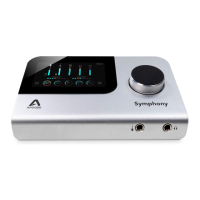Apogee Symphony Desktop User’s Guide
Apogee Alloy Mic Preamp Emulation
Apogee Alloy mic preamp emulation offers analog circuitry plus DSP processing to create the richest,
most authentic audio modeling available in an audio interface. Critical aspects of the model such as
input impedance, transient profile and distortion characteristics are first implemented in the analog
domain, followed by precise and accurate refinement in DSP, for a hybrid result that’s greater than
the sum of its parts.
The AP-66 emulation is based on the Class A solid-state Neve 1066 mic preamp, with a characteristic
low-mid color and slightly compressed transients.
The AP-57 emulation offers the lush, larger-than-life tube saturation of a carefully restored 50s era
Ampex 601 preamp.
Innovative Workflows with Hardware DSP
Symphony Desktop includes flexible and powerful onboard DSP processing that supports a wide
range of innovative workflows, using the Apogee Channel FX plugin. Whether you’re printing your
tracks with Apogee Alloy mic preamp emulation or enjoying the benefits of DualPath monitoring,
there’s a DSP-powered workflow that fits you like a glove.
Apogee Plugins Included
Included with Symphony Desktop is the Symphony ECS Channel Strip plugin. Tuned by Bob
Clearmountain, Symphony ECS includes EQ, Compression and Saturation for quick and effective
processing when tracking vocals or acoustic instruments.
Also included is the Apogee Clearmountain’s Spaces plugin, which reproduces legendary mixer Bob
Clearmountain’s personalized workflow for creating the distinctive, rich spaces where his mixes live.
With the very same echo chamber profiles and processing he’s used on countless hit records,
Clearmountain’s Spaces lets you envelope your tracks in unique and cohesive atmospheres that set
your mixes apart.
Zero-Ohm Headphone Outputs
Symphony Desktop has two completely independent ultra low impedance headphone outputs that are
individually routable, equipped with dual-sum ESS DACs. Output power range is tailored to the
expected type of headphones: the front panel output can drive virtually any headphones, while the
rear panel output is specifically designed for high-efficiency headphones.
5

